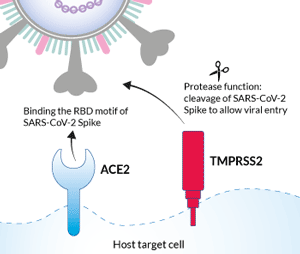SARS-CoV-2-Cellular Receptor Genes
 InvivoGen also offers:
InvivoGen also offers:
ACE2 & TMPRSS2
Human ACE2 (angiotensin I-converting enzyme-2) and TMPRSS2 (transmembrane protease serine 2) are two surface membrane receptors that are involved in SARS-CoV-2 (or 2019-nCoV) entry into host target cells [1-3].
Virus docking to the cells occurs upon binding of the viral Spike protein to ACE2. The virus can then use either endocytosis or fusion with the surface membrane to enter the cells. In both cases, ACE2-bound Spike must be cleaved ("activated") by specific proteases to allow the Spike fusion domains to operate. In the endosomes, Spike is cleaved by Cathepsin L, then the viral membrane fuses with the endocytic membrane. At the cell surface, Spike is cleaved by other proteases, mainly TMPRSS2, to ensure virus and host-cell membrane fusion [1-3]. After the fusion, SARS-CoV-2 genomic and protein content is delivered into the cytosol, and the virus starts its replication cycle.
InvivoGen offers the human ACE2 and TMPRSS2 genes cloned either individually or together into mammalian expression plasmids.
![]() Read our reviews on COVID-19:
Read our reviews on COVID-19:
➤ The infection cycle of SARS-CoV-2
➤ Treatment with repurposed drugs
➤ Predicted host immune responses to SARS-CoV-2
➤ Vaccine development
➤ Protective immunity & Re-infection
References
1. Hoffmann M. et al., 2020. SARS-CoV-2 cell entry depends on ACE2 and TMPRSS2 and is blocked by a clinically proven protease inhibitor. Cell. 181:1-16.
2. Walls A.C. et al., 2020. Structure, function, and antigenicity of the SARS-CoV-2 spike glycoprotein. Cell. 181(2):281-292.e6.
3. Hoffmann M. et al., 2020. A multibasic cleavage site in the Spike protein of SARS-CoV-2 is essential for infection of human lung cells. Molecular Cell. 78:1-6.





